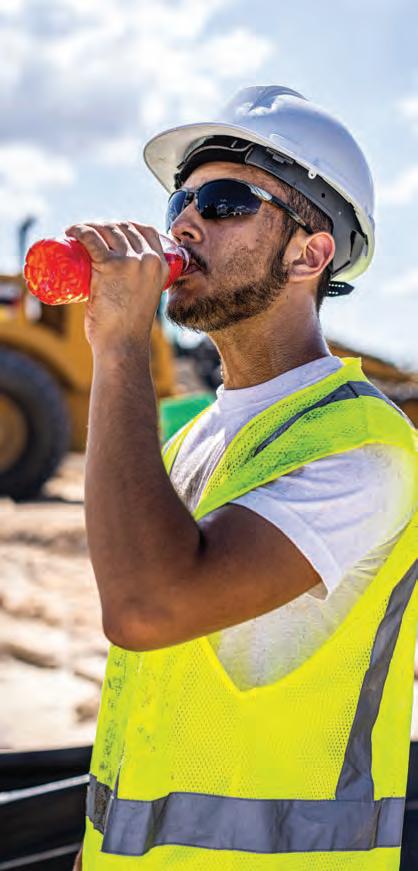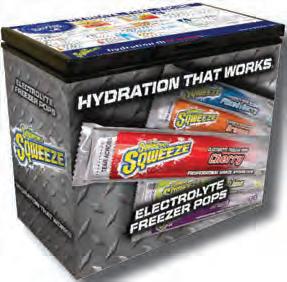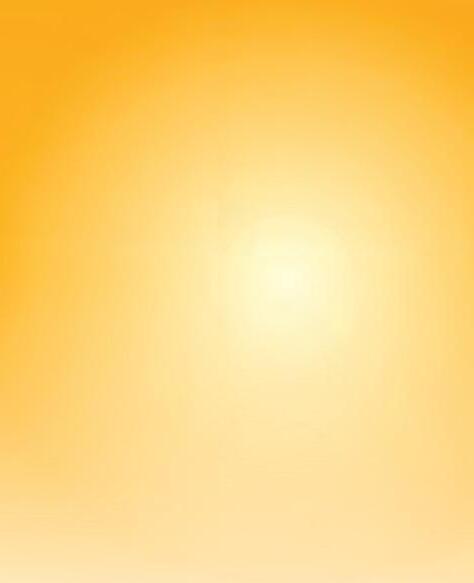
3 minute read
Protect your team from
$421 each COOLING TOWEL
Provides hours of cooling relief
Advertisement
$321 each COOLING NECK WRAP
• Reusable for lasting heat stress management
Antimicrobial treated material to help avoid mold
• Machine washable
• Quick activation and reactivation
• Reusable packaging for proper storage
Recognizing Different Types of Heat Stress
Heat Stroke is the most serious heat-related health problem. Heat stroke occurs when the body’s temperature regulating system fails and body temperature rises to critical levels (greater than 104°F). This is a medical emergency that may result in death! The signs of heat stroke are confusion, loss of consciousness, and seizures. Workers experiencing heat stroke have a very high body temperature and may stop sweating.
If a worker shows signs of possible heat stroke, get medical help immediately, and call 911. Until medical help arrives, move them to a shady, cool area and remove as much clothing as possible. Wet the worker with cool water and circulate the air around them to speed cooling. Place cold wet cloths, towels (e.g. Majestic cooling towels), or ice all over their body or soak clothing with cold water.

Heat Exhaustion is the next most serious heat-related health problem. The signs and symptoms of heat exhaustion are headache, nausea, dizziness, weakness, irritability, confusion, thirst, heavy sweating and a body temperature greater than 100.4°F. Workers with heat exhaustion should be removed from the hot area and given liquids to drink. Cool them with cold compresses to the head, neck, and face or have the worker wash his or her head, face and neck with cold water. Encourage frequent sips of cool water. Those with signs or symptoms of heat exhaustion should be taken to a clinic or emergency room for medical evaluation and treatment. Make sure that someone stays with the worker until help arrives. If symptoms worsen, call 911 and get help immediately.
Heat Cramps are muscle pains usually caused by the loss of body salts and fluid during sweating. Workers with heat cramps should replace fluid loss by drinking water and/ or carbohydrate-electrolyte replacement liquids (e.g., Sqwincher beverages) every 15 to 20 minutes.
Heat Rash is the most common problem in hot work environments. Heat rash is caused by sweating and looks like a red cluster of pimples or small blisters. Heat rash may appear on the neck, upper chest, groin, under the breasts and in elbow creases. The best treatment for heat rash is to provide a cooler, less humid work environment. The rash area should be kept dry. Powder may be applied to increase comfort. Ointments and creams should not be used on a heat rash. Anything that makes the skin warm or moist may make the rash worse. Adapted fromOSHA DTSEM FS-3743 08/2014 norco-inc.com/spring-summer
Please Note: Products and prices shown are subject to change due to manufacturer’s availability.
Key Signs of Dehydration
Strenuous tasks, especially in hot and humid environments, can cause the body to lose fluids quickly. If they aren’t replaced, dehydration can set in. Mild dehydration is defined as a 1.5% loss in the body’s water volume, and symptoms gradually get worse as it progresses. A loss of 15% can be enough to cause death!

We lose an average of 2.5 liters of water each day through normal bodily processes, like breathing, urinating, and sweating. But those who engage in hard, physical labor can experience greater fluid loss.

Unfortunately, most people wait until they’re thirsty to take a drink. The truth is that if you’re feeling thirst, you’re already slightly dehydrated.
Catching dehydration early is key, before it has an impact on cognitive and physical function. Read on for signs to watch for.
Headaches are an early sign of potential dehydration. They are often accompanied by tiredness and light-headedness, and can be remedied within about 30 minutes by drinking the right fluids like Sqwincher elctrolyte replenishment beverages.

Urine color is one of the easiest ways to assess hydration level.

Clear to pale yellow urine is a sign of proper hydration. A light honey color suggests that you should rehydrate soon, and darker yellow is a sign that your body needs water immediately.
Excessive perspiration isn’t a symptom of dehydration, but a sign that you are losing fluid and may be at risk for dehydration. If you’re sweating heavily, use it as a reminder to stay hydrated and drink replenishing fluids. Inability to focus is a key indicator that your body is running low on fluids. The brain requires sufficient hydration to run at capacity, and those who are dehydrated may notice short-term memory lapses and poor levels of concentration and focus.
Bad breath is a little known, but important sign. A lack of fluids can prevent your body from producing enough saliva, which leads to bacteria growth in the mouth and bad breath. Food cravings arise for a variety of reasons, one of which could be dehydration. Dehydration can make it difficult for organs like the liver to produce glycogen, and this can lead to food cravings.






